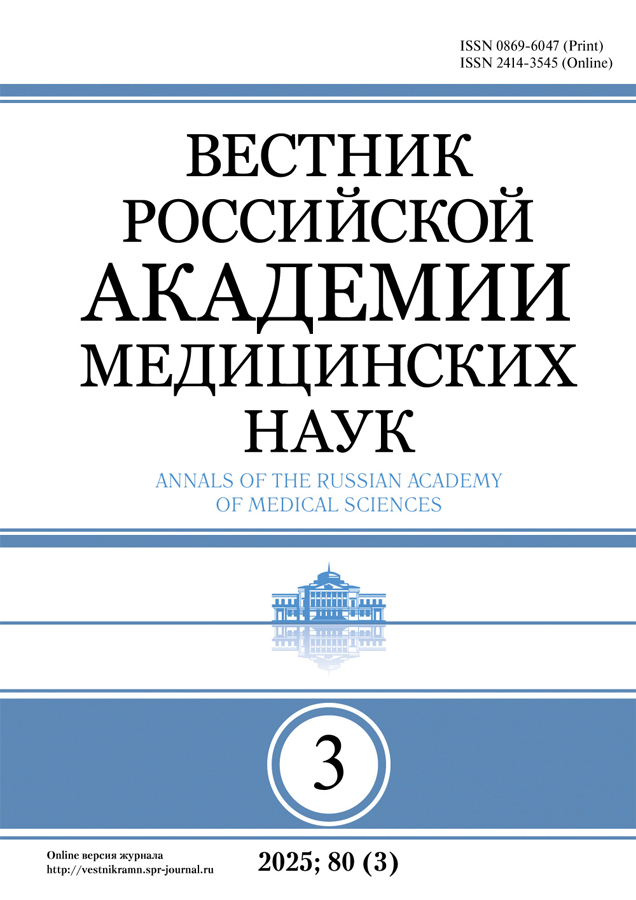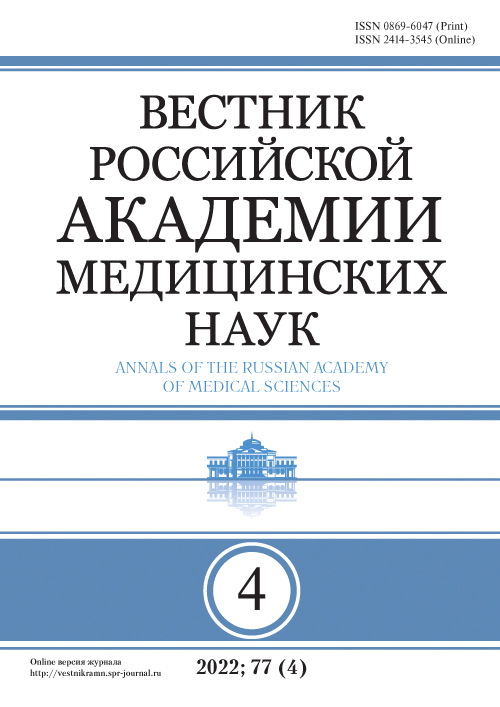Том 77, № 4 (2022)
- Год: 2022
- Дата публикации: 14.11.2022
- Статей: 7
- URL: https://vestnikramn.spr-journal.ru/jour/issue/view/87
- DOI: https://doi.org/10.15690/vramn.774
Весь выпуск
АКТУАЛЬНЫЕ ВОПРОСЫ ГАСТРОЭНТЕРОЛОГИИ
Современная лучевая диагностика и интеллектуальные персонализированные технологии в гепатопанкреатологии
Аннотация
Своевременная инструментальная диагностика заболеваний гепатопанкреатодуоденальной области, особенно онкологического характера, является залогом успешного лечения, улучшения прогноза и повышения качества жизни пациентов. На данный момент возможности лучевой диагностики позволяют выявить и оценить характер кровоснабжения новообразования, его распространенность, целлюлярность, а в случае МР-исследования с гепатоспецифическими контрастными препаратами — также оценить и функциональную активность печеночных клеток. Тем не менее неуклонное развитие методов лечения онкологических пациентов, в частности химиотерапии, и персонализированного подхода к выбору тактики ведения пациента требует подробной оценки морфологических типов тех или иных новообразований. Необходимость динамического наблюдения результатов проведенного лечения, мониторинга случайно выявленных, потенциально злокачественных новообразований, развитие скрининговых программ обусловливают неуклонный рост количества выполняемых ежегодно в мире и в нашей стране КТ- и МРТ-исследований. Эти факторы послужили причиной применения текстурного анализа и алгоритмов машинного обучения. При этом такие методики, как рентгенография, УЗИ, КТ и МРТ с внеклеточным и тканеспецифическим контрастным усилением и МРТ-ДВИ, не утрачивают своего значения. Проводимые исследования позволяют ФГБУ НМИЦ хирургии им. А.В. Вишневского Минздрава России реализовать концепцию дооперационной неинвазивной диагностики и дифференциальной диагностики хирургических и онкологических заболеваний гепатопанкреатодуоденальной области и применять полученные знания в планировании оперативного лечения. Реализация проблемы постпроцессорной обработки данных лучевой диагностики хирургических и онкологических заболеваний гепатопанкреатодуоденальной области с применением технологий текстурного анализа и искусственного интеллекта важна и чрезвычайно актуальна для современной медицины.
 245-253
245-253


АКТУАЛЬНЫЕ ВОПРОСЫ ИНФЕКЦИОННЫХ БОЛЕЗНЕЙ
COVID-19 в России: эпидемиология и молекулярно-генетический мониторинг
Аннотация
Обоснование. Пандемия COVID-19 выявила проблемы здравоохранения, но в то же время стала мощным импульсом для развития новых научных исследований в области эпидемиологии, клиники инфекционных болезней, диагностики, биоинформатики и цифровых методов. На базе ФБУН «ЦНИИ эпидемиологии» Роспотребнадзора (ЦНИИ эпидемиологии) разработаны новые уникальные тест-системы для обнаружения РНК SARS-CoV-2 на основе ПЦР в режиме реального времени с использованием технологии петлевой изотермической амплификации (ИТ), которая позволяет исследовать образцы быстрее в 3–4 раза, чем разработанные ранее методы. В ЦНИИ эпидемиологии разработана и введена в действие российская платформа агрегации информации о геномах вирусов — VGARus, которая содержит информацию о нуклеотидных последовательностях вирусов SARS-CoV-2 и их мутациях, а также создана интеграционная платформа SOLAR для быстрой передачи результатов ПЦР-исследований всем заинтересованным гражданам Российской Федерации.
Цель исследования — изучение проявлений эпидемического процесса COVID-19 и распространенности геновариантов вируса SARS-CoV-2 на территории Российской Федерации.
Методы. Проведен ретроспективный эпидемиологический анализ заболеваемости COVID-19 с 30 марта 2020 по 17 мая 2022 г. на территории Российской Федерации. Использована база данных, сформированная на основе материалов формы отчета Роспотребнадзора № 970 «Информация о случаях инфекционных заболеваний у лиц с подозрением на новую коронавирусную инфекцию», использованы данные ВОЗ, отечественного информационного портала Стопкоронавирус.рф и сервиса визуализации и анализа данных Yandex DataLens, информация по геновариантам SARS-CoV-2 базы данных VGARus.
Результаты. При анализе проявлений эпидемического процесса COVID-19 на территории Российской Федерации за 2020–2022 гг. выделены два этапа. Первый характеризовался быстрым распространением вируса SARS-CoV-2 из мегаполисов в другие субъекты РФ и применением мер неспецифической профилактики. Начало второго этапа было обусловлено эволюцией вируса SARS-CoV-2 и изменением его биологических свойств, с последующей сменой превалирующих геновариантов на территории России.
Заключение. В результате исследования установлено, что с каждым последующим ростом заболеваемости COVID-19 происходило снижение тяжести течения и доли пневмоний в структуре клинических форм заболевания.
 254-260
254-260


АКТУАЛЬНЫЕ ВОПРОСЫ КАРДИОЛОГИИ И СЕРДЕЧНО-СОСУДИСТОЙ ХИРУРГИИ
Взаимосвязь воспаления и нарушений гемостаза при сердечно-сосудистых и инфекционных заболеваниях
Аннотация
Тромбоз и воспаление взаимно активируются при воспалительных, сердечно-сосудистых и инфекционных заболеваниях. Тромбоз сопровождается развитием воспаления и изменениями иммунного ответа, при воспалении активируется гемостаз и формируются внутрисосудистые тромбы. При совместном применении противовоспалительных и антитромботических средств нередко возникают побочные эффекты, например, нестероидные противовоспалительные средства вызывают образование язв в желудке, осложненных кровотечением. В патогенезе тромбоза и воспаления большое значение имеет дисфункция сосудистого эндотелия, и разработка лекарственных средств, улучшающих функции эндотелия, представляется перспективным подходом для предотвращения тромботических событий, являющихся следствием воспаления или инфекционного заболевания.
 261-266
261-266


АКТУАЛЬНЫЕ ВОПРОСЫ НЕВРОЛОГИИ И НЕЙРОХИРУРГИИ
Современная нейрохирургия: междисциплинарная интеграция компетенций и технологий
Аннотация
Современная нейрохирургия базируется на комплексной интеграции достижений фундаментальных и прикладных нейронаук и технологий. Значительное количество разных диагностических и лечебных подходов применяется с целью продлить жизнь пациента и максимально сохранить ее качество. При этом нейрохирургия — единственная клиническая дисциплина, в рамках которой возможно прямое наблюдение работы живого мозга человека. Большие объемы информации о состоянии нервной системы и о ее патологии, рутинно порождаемые в нейрохирургии, привлекают специалистов смежных медицинских и биологических наук для проведения комплексных исследований. Такое тесное сотрудничество врачей, биологов, химиков, физиков, математиков, инженеров и других специалистов обеспечивает быстрое и непрерывное совершенствование методов хирургического лечения патологии нервной системы. Настоящая статья знакомит со спектром технологий в современной нейрохирургии, исследовательских задач, стоящих перед врачами этой специальности, а также кратко освещает деятельность Национального медицинского исследовательского центра нейрохирургии имени академика Н.Н. Бурденко — головного нейрохирургического учреждения Российской Федерации — в приоритетных клинических и научных направлениях.
 267-275
267-275


АКТУАЛЬНЫЕ ВОПРОСЫ ПЕДИАТРИИ
Оценка медико-экономической эффективности внедрения неинвазивного пренатального теста: международный опыт
Аннотация
Неинвазивное пренатальное тестирование (НИПТ) — это молекулярно-генетическое исследование, основанное на анализе внеклеточной фетоплацентарной ДНК в крови матери и позволяющее оценить риск хромосомных аномалий плода. В настоящее время НИПТ достаточно широко распространено во всем мире, неоднократно доказана его клиническая эффективность — высокая чувствительность и специфичность. Вместе с тем для принятия решения о включении НИПТ в алгоритм пренатальной диагностики, проводимой за счет государственных средств, важна его экономическая эффективность, которую необходимо оценивать отдельно для каждой страны или территории ввиду различной стоимости и различных моделей включения. В данной статье представлены подходы некоторых стран к оценке медико-экономической эффективности проведения НИПТ.
 276-284
276-284


АКТУАЛЬНЫЕ ВОПРОСЫ ФИЗИОЛОГИИ
Изучение генерации синглетного кислорода в слюне человека in vitro под действием наносекундного импульсного лазерного излучения
Аннотация
Обоснование. Необходима разработка новых лазерных аппаратов для применения в терапии сложной стоматологической патологии и микрохирургии полости рта с уникальными параметрами, с возможностью генерации наносекундного импульсного излучения в квазимонохроматической полосе излучения. Высокая пиковая мощность излучения в импульсе позволяет лазерному свету глубже проникать в биологические среды без существенного их нагрева. Возможность возбуждения синглетного кислорода без использования эндогенных фотосенсибилизаторов является неоспоримым преимуществом таких лазерных генераторов.
Цель исследования — изучение генерации синглетного кислорода в ротовой жидкости человека in vitro в зависимости от параметров наносекундного импульсного лазерного излучения с длиной волны ~1265 нм.
Методы. В работе использовалось лазерное устройство, имеющее основной инфракрасный (ИК) излучатель с длиной волны, примерно соответствующей максимуму поглощения кислорода (~1265 нм), с генерированием наносекундного импульсного излучения. Изучалась генерация синглетного кислорода в ротовой жидкости человека и смыве ротовой жидкости по выцветанию ловушки в растворах под действием лазерного излучения до облучения через и 30 и 60 мин. Были установлены следующие параметры лазерного излучения: мощность — 1 Вт, наносекундное импульсное излучение с длительностью импульса 400 нс и частотой 0,5; 1,0; 1,5 и 2,0 МГц в сравнении с непрерывным режимом излучения.
Результаты. Установлено, что наносекундное лазерное излучение приводит к окислению химической ловушки синглетного кислорода, солюбилизированной детергентом додецилсульфат натрия (0,05 М SDS), в ротовой жидкости и смыве слюны из полости рта. В импульсных наносекундных режимах лазерное излучение более эффективно, чем в непрерывном режиме. С увеличением частоты повторения наблюдалось повышение эффекта в среднем на 10% по сравнению с меньшей частотой, а эффект с максимальной частотой 2,0 МГц был практически на 50% выше, чем при использовании непрерывного режима излучения, во всех проведенных исследованиях. Уменьшение оптической плотности при 414 нм достоверно отмечалось в образцах со смывом ротовой жидкости, эффект составил 0,07 ± 0,01 за 60 мин облучения. В ротовой жидкости эффект при тех же параметрах был чуть ниже и составил 0,05 ± 0,03.
Заключение. Скорость выцветания ловушки в смыве слюны оказалась в 1,3 раза больше, чем в воде с детергентом, что может свидетельствовать об активации фотоакцепторов и перенасыщении их кислородом при использовании водного разведения ротовой жидкости. Максимальный эффект наблюдался при использовании лазерного излучения с частотой повторения импульсов 2,0 МГц.
 285-290
285-290


АКТУАЛЬНЫЕ ВОПРОСЫ ЭПИДЕМИОЛОГИИ
COVID-19 в России: эволюция взглядов на пандемию. Сообщение 2
Аннотация
За два года пандемии новой коронавирусной инфекции (COVID-19) произошла эволюция взглядов в различных областях медицины, что привело к мощному развитию научных исследований в области эпидемиологии, клиники, диагностики и терапии COVID-19. В данной статье освещены вопросы эволюции взглядов и подходов к изучению клиники и терапии COVID-19. Установлены симптомы и утяжеление течения сердечно-сосудистых заболеваний при COVID-19. Указана основная стратегия организации хирургической помощи пациентам с COVID-19. Описаны основные критерии терапии COVID-19, необходимости назначения CГКС на индивидуальной основе и необходимости поиска новых методов противовоспалительной терапии COVID-19, одним из которых может стать применение алкилирующих препаратов в ультранизких дозах.
 291-306
291-306













